Physical Address
304 North Cardinal St.
Dorchester Center, MA 02124
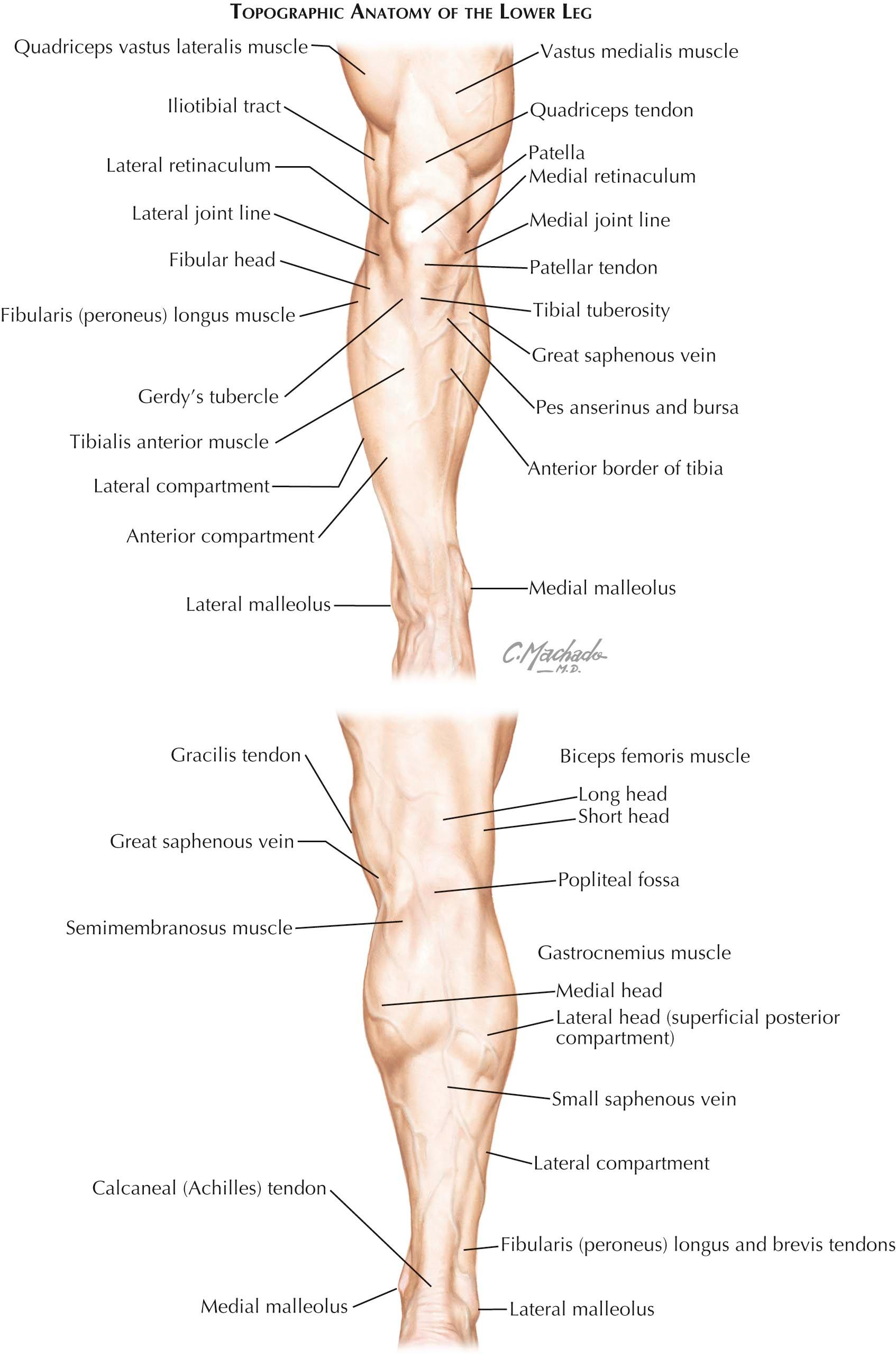
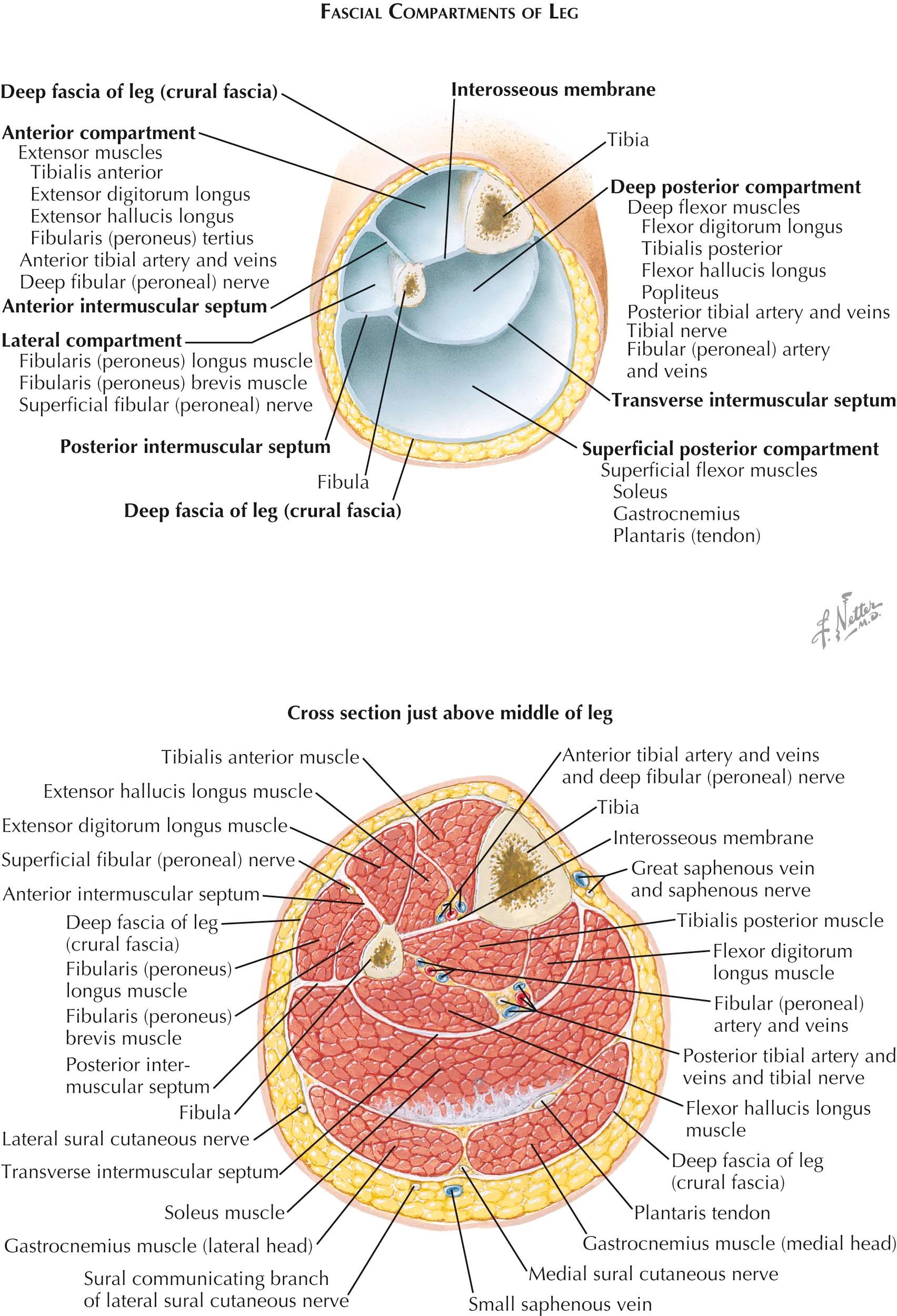
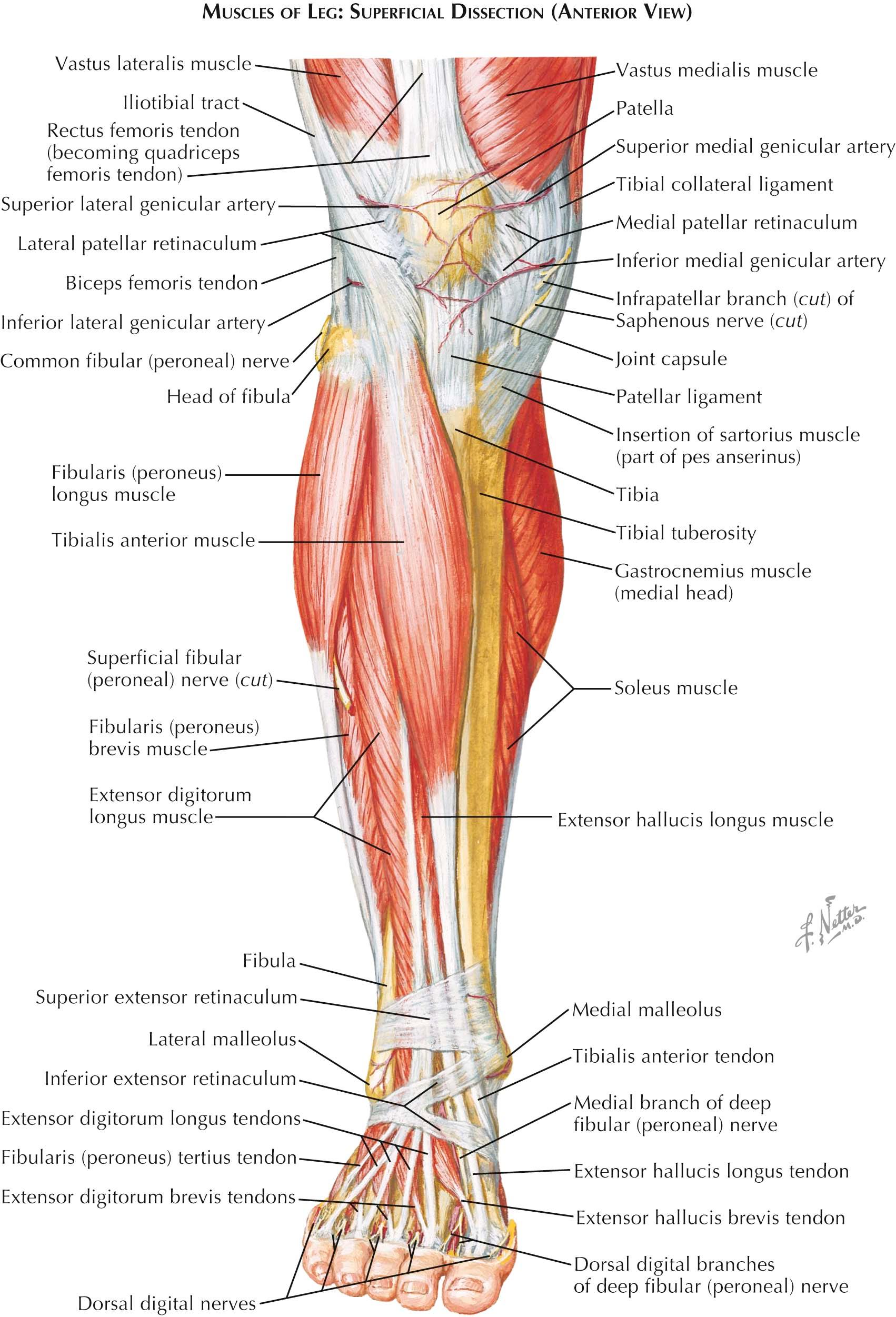
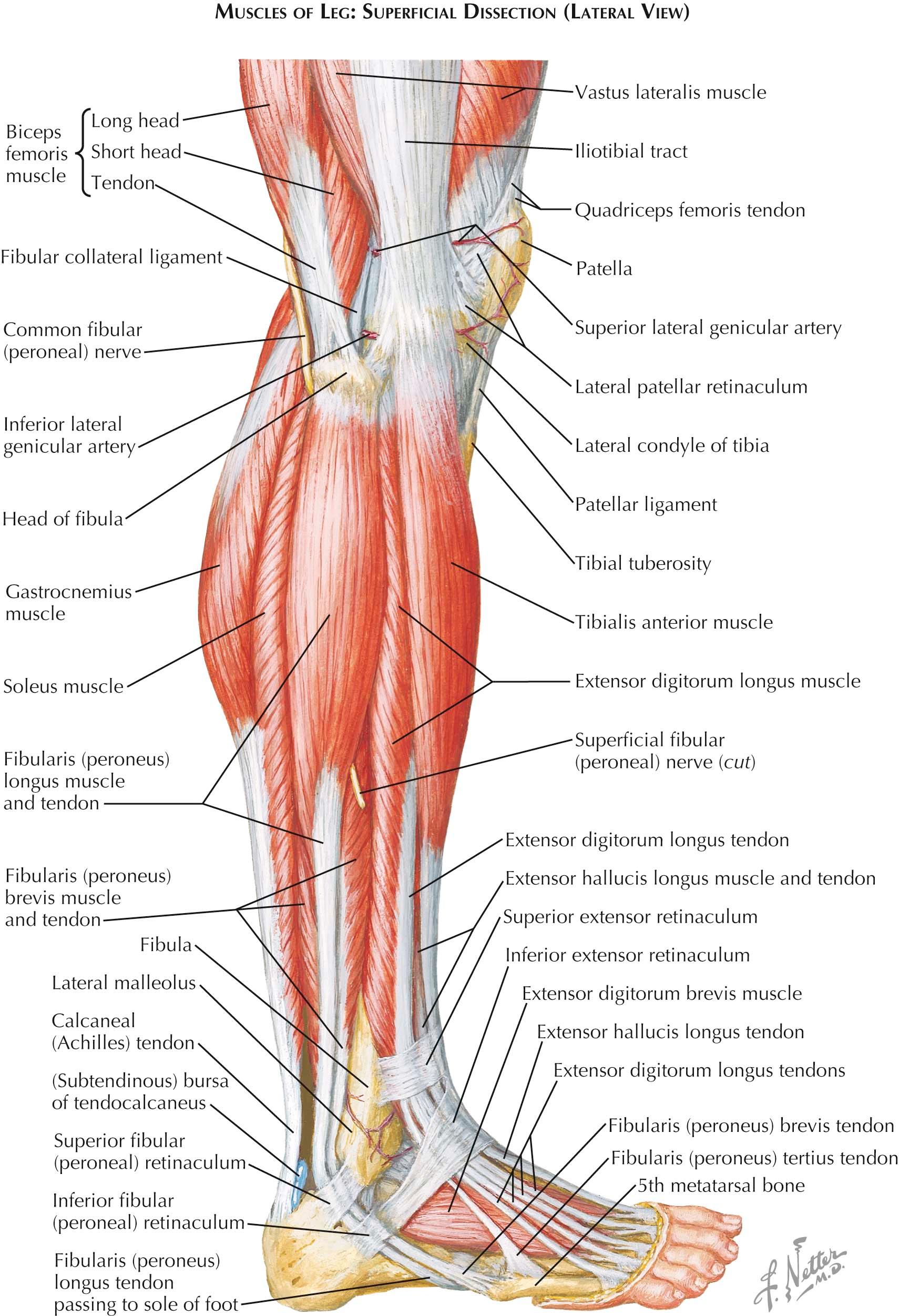
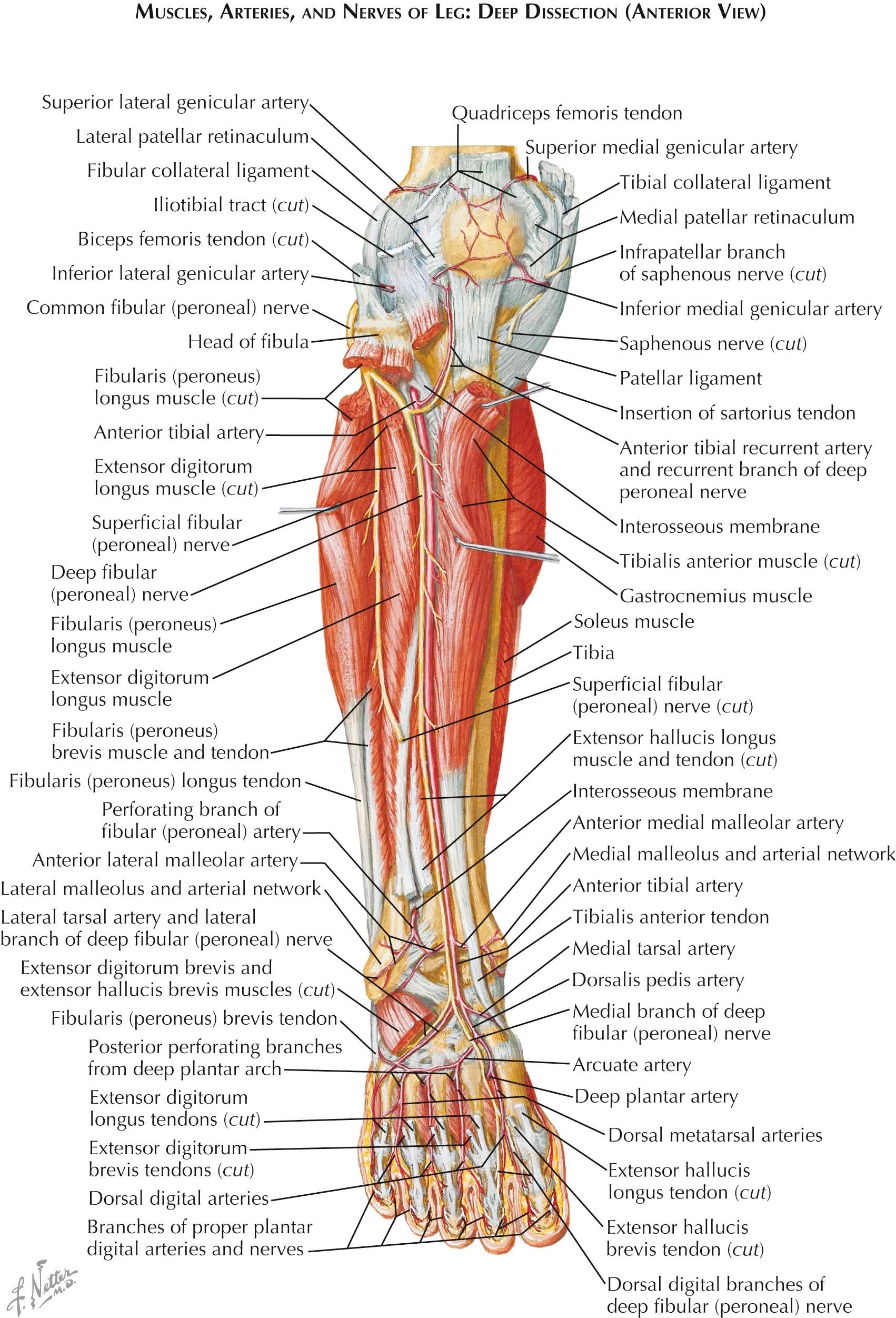
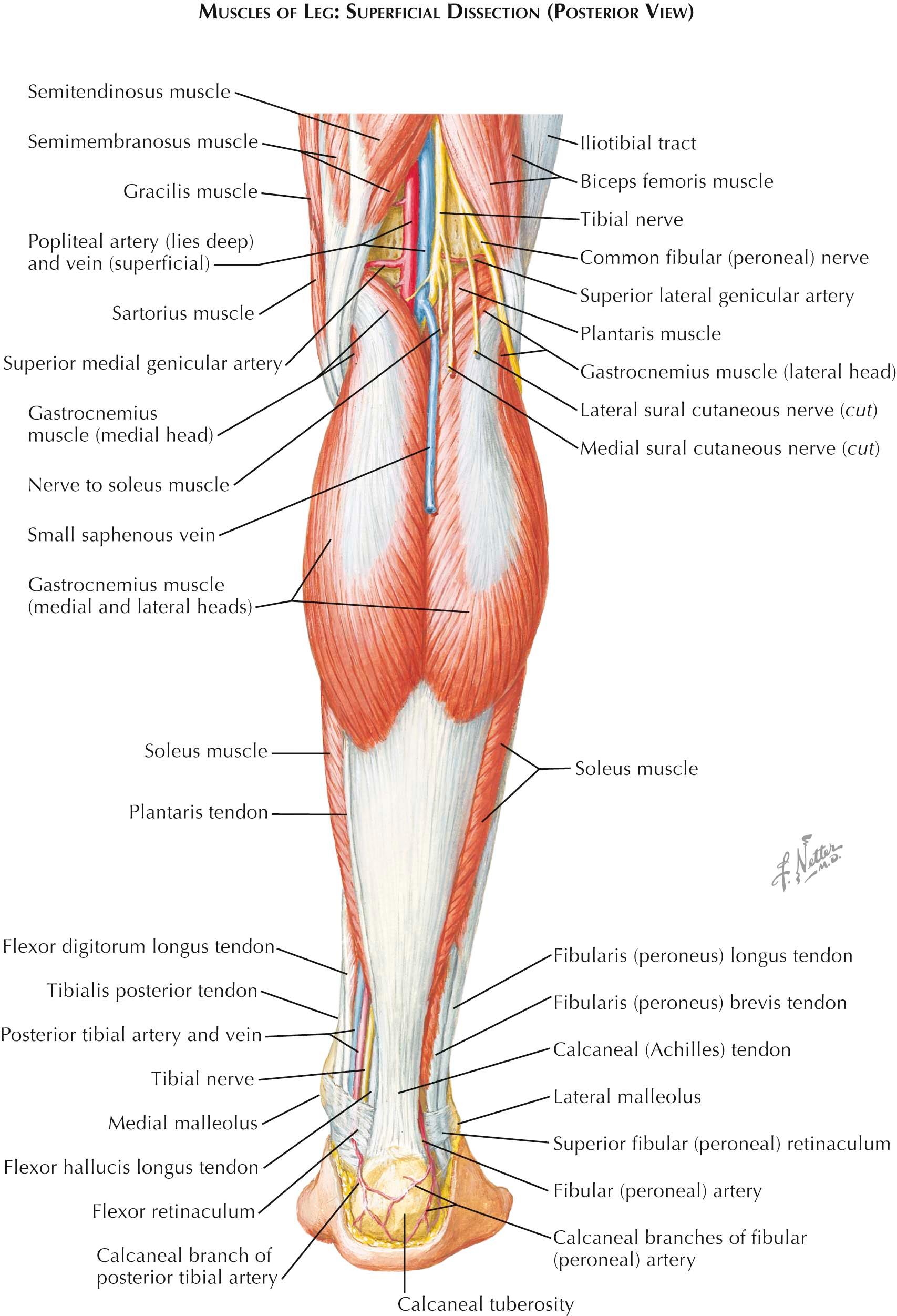

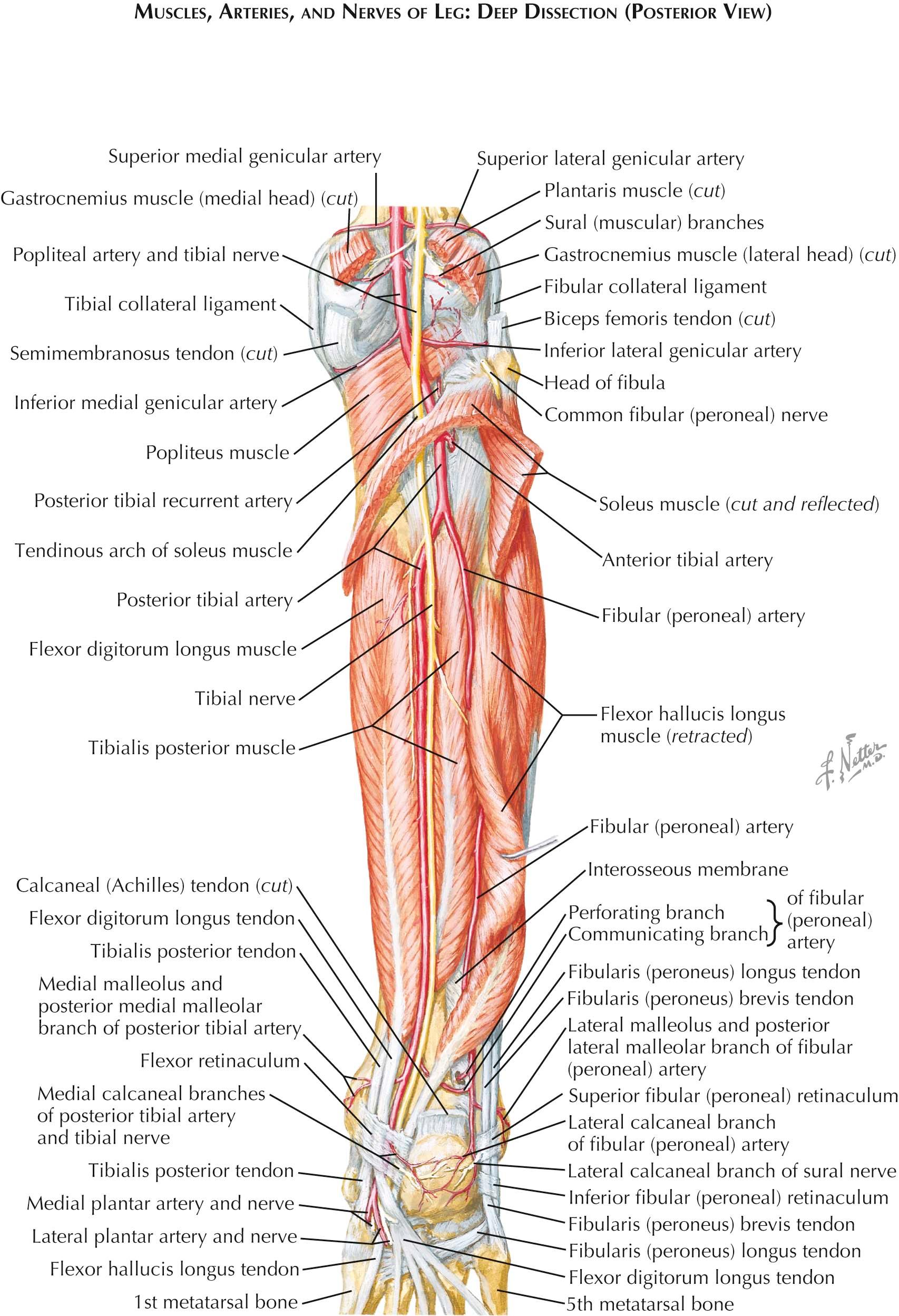
The fascia lata of the thigh continues into the leg, where it is designated as the crural fascia (see Plate 4-2 ). At the knee, the fascia has many attachments—the patella, patellar ligament, tibial tuberosity, condyles of the tibia, and head of the fibula—that reinforce the medial and lateral patellar retinacula. The fascia is strengthened by expansions of the tendons of the sartorius, gracilis, semitendinosus, and biceps femoris muscles. Covering the soft parts of the leg, the crural fascia gives origin to superficial muscle fibers and blends with the periosteum of the subcutaneous surface of the tibia. Above the ankle, it blends with the periosteum of the lower part of the shaft of the fibula. Distally, it attaches to the medial and lateral malleoli and the calcaneus.
Deep extensions of the crural fascia separate certain compartments of the leg. The anterior and posterior lateral intermuscular septa dip deeply to attach to the anterior and posterior borders of the fibula, respectively. They define the lateral compartment of the leg, separating it from the anterior and posterior compartments. From the posterior intermuscular septum adjacent to the fibula, the transverse intermuscular septum (deep transverse fascia of the leg) extends medialward, ending on the tibia and in the crural fascia behind it. It separates the superficial and deep posterior compartments of the leg. This sheet is thick over the popliteus muscle and, in the lower part of the leg, lies anterior to the calcaneal tendon. At the ankle, further thickenings of the crural fascia enclose the soft parts and prevent the tendons from bowstringing. One of these is the superior extensor retinaculum, which spans across anteriorly from the tibia to the fibula, covers all the muscles of the anterior compartment, and restrains their tendons.
The three intermuscular septa of the leg and the interosseous membrane between the tibia and fibula and the crural fascia define the anterior, lateral, superficial posterior, and deep posterior compartments of the leg. These compartments contain groups of related muscles and vessels and nerves appropriate to them. The two posterior compartments contain preaxial muscles and are served by the tibial nerve; the anterior and lateral compartments contain postaxial muscles and are served by the common peroneal nerve (see Plate 4-2 ).
The anterior compartment contains the tibialis anterior, extensor hallucis longus, extensor digitorum longus, and peroneus tertius muscles, which extend the toes and dorsiflex the foot. In addition, the tibialis anterior muscle inverts the sole of the foot (see Plate 4-3 ).
The tibialis anterior muscle lies against the lateral surface of the tibia. It arises from the lateral condyle of the tibia and from the upper two thirds of its lateral surface. Fibers also take origin from the interosseous membrane, the overlying crural fascia, and the intermuscular septum between it and the extensor digitorum longus muscle. The tendon appears in the lower third of the leg and passes under the superior and inferior extensor retinacula surrounded by a synovial sheath. It inserts into the medial and inferior surface of the medial cuneiform and the base of the first metatarsal (see Plate 4-5 ). The tibialis anterior muscle is innervated by the deep peroneal nerve.
The extensor hallucis longus muscle is a thin muscle that outcrops between the tibialis anterior and extensor digitorum longus muscles in the lower half of the leg. It arises from the middle half of the anteromedial surface of the fibula and from the interosseous membrane for the same distance. Its tendon develops on the superficial surface, passes under the two extensor retinacula, and inserts into the dorsal base of the distal phalanx of the great toe. The extensor hallucis longus functions in extension of the great toe and dorsiflexion of the foot. It is innervated by the deep peroneal nerve (see Plate 4-3 ).
The extensor digitorum longus muscle occupies the fibular part of the anterior compartment. This pennate muscle arises from the lateral condyle of the tibia, the anterior surface of the fibula, the intermuscular septa (between it and the tibialis anterior muscle and between it and the peroneus longus), and the crural fascia near the tibia. The tendon begins at about the middle of the leg and receives fibers nearly to the ankle. Below the superior extensor retinaculum, the tendon divides into two parts, which pass under the inferior extensor retinaculum. The four tendons cross the dorsum of the foot inserting onto the middle and distal phalanges of the lateral four toes via dorsal digital expansions. The extensor digitorum longus functions to extend the lateral four toes and is innervated by the deep peroneal nerve.
The tendons of the extensor digitorum longus muscle mimic the divisions and expansions characteristic of the tendons of the extensor digitorum muscle in the hand. They divide into two lateral slips and one central slip; the central slip ends on the dorsum of the middle phalanx, and the lateral slips converge distally to end on the base of the distal phalanx. Extensor expansions are formed over the metatarsophalangeal joints, and, distally, the tendons of the interosseous and lumbrical muscles join the lateral slips of the tendon. The tendons of the extensor digitorum brevis muscle join the tendons of the extensor digitorum longus muscle on their fibular sides and help form the extensor expansions of the second, third, and fourth toes.
The peroneus tertius muscle is essentially a lateral slip of the extensor digitorum longus muscle; it is seldom completely separate, except at its insertion. It arises from the distal third of the anterior surface of the fibula, the adjacent interosseous membrane, and the anterior intermuscular septum. Descending under the extensor retinacula in the compartment for the extensor digitorum longus, it turns lateralward to end on the dorsum of the base of the fifth metatarsal. The peroneus tertius dorsiflexes and everts the foot. It is innervated by the deep peroneal nerve.
The lateral compartment contains the peroneus longus and the peroneus brevis muscles (see Plate 4-4 ).
The bipennate peroneus longus muscle arises higher in the leg and is more superficial. It takes its origin from the head and upper two thirds of the lateral surface of the body of the fibula, the anterior and posterior intermuscular septa, and the crural fascia. Its tendon begins high on the superficial surface of the muscle and receives fibers (posteriorly) to almost the lateral malleolus. Behind the lateral malleolus, the tendon is posterior to the tendon of the peroneus brevis; both are enclosed within a common synovial sheath and pass under the superior peroneal retinaculum. The tendon of the peroneus longus muscle passes diagonally forward, inferior to the tendon of the peroneus brevis muscle, and turns into the foot against the anterior slope of the tuberosity of the cuboid. A sesamoid (os peroneum) in the tendon protects it over the tuberosity. Crossing the sole of the foot deep to its intrinsic muscles, the peroneus longus tendon ends on the inferolateral surface of the medial cuneiform and on the base and inferolateral surface of the first metatarsal. The peroneus longus everts, plantar flexes, and abducts the foot. It is innervated by the superficial peroneal nerve.
The peroneus brevis muscle lies deep to the peroneus longus muscle and is smaller and shorter. It arises from the lower two thirds of the lateral surface of the fibula and from the anterior and posterior intermuscular septa. Its tendon grooves the back of the lateral malleolus, lying in a common synovial sheath with the tendon of the peroneus longus. Turning forward under the superior peroneal retinaculum, it passes through the inferior peroneal retinaculum to insert into the tuberosity on the base of the fifth metatarsal. The peroneus brevis muscle is an everter of the foot and is innervated by the superficial peroneal nerve.
The gastrocnemius and soleus muscles are supplemented by the almost vestigial plantaris muscle to form a triceps surae complex in the superior posterior compartment (see Plates 4-6 and 4-7 ). The more superficial gastrocnemius muscle arises by two heads. The larger medial head takes origin from the popliteal surface of the femur immediately above the medial femoral condyle. The lateral head arises from the upper posterior portion of the lateral surface of the lateral femoral condyle and from the end of the supracondylar line. Bursae separate both heads from the capsule of the knee joint. The fibers of both heads converge toward the midline of the leg and unite at about its mid length into a tendinous raphe, which broadens into an aponeurosis on the anterior surface of the muscle. This aponeurosis fuses below with the tendon of the soleus muscle and, with it, forms the calcaneal tendon. The medial head is usually somewhat broader and thicker, and its muscular fibers descend a bit farther toward the heel. The gastrocnemius plantar flexes the foot, and because it crosses the knee joint it also flexes the knee. It is innervated by the tibial nerve.
The soleus muscle is broad and flat, lying immediately anterior to the gastrocnemius muscle but arising entirely below the knee. It has a triple origin from (1) the posterior surfaces of the head of the fibula and the upper third of its shaft, (2) a tendinous arch between the tibia and fibula that represents the upper part of the transverse intermuscular septum, and (3) the soleal line of the tibia and its medial border along its middle third. The muscle fibers converge into a broad aponeurosis, which fuses below with that of the gastrocnemius muscle to form the calcaneal tendon, the thickest and strongest tendon in the body. The soleus muscle plantar flexes the foot and is innervated by the tibial nerve.
The calcaneal tendon is about 15 cm long, begins at the middle of the leg, and receives muscular fibers almost to its termination. Narrowed below, it inserts into the middle part of the posterior surface of the calcaneus; a bursa lies deep to the tendon and separates it from the upper part of the posterior surface of the bone.
The plantaris muscle arises from the lower lateral supracondylar line of the femur immediately above the lateral head of the gastrocnemius muscle and from the oblique popliteal ligament. Its short (10 cm) belly ends in a long slender tendon, which descends between the gastrocnemius and soleus muscles and then continues along the medial border of the calcaneal tendon to insert into the calcaneus. The plantaris muscle plantar flexes the foot and also flexes the knee. It is innervated by the tibial nerve.
The deep posterior compartment contains the popliteus, flexor hallucis longus, flexor digitorum longus, and tibialis posterior muscles (see Plate 4-8 ).
The popliteus muscle, a thin, flat muscle of triangular outline, occupies the floor of the lower part of the popliteal fossa. It arises mainly by a stout cord from the anterior end of the groove on the lateral face of the lateral femoral condyle, close to the articular margin. The tendon passes between the lateral meniscus and the capsule of the knee joint, with the subpopliteal recess of synovial membrane lying between them. As much as one half of its fibers may come from the arcuate popliteal ligament, with others arising in the lateral meniscus. The muscle inserts by fleshy fibers into the triangular area above the soleal line of the back of the tibia. The popliteus rotates the femur laterally on the tibia to help initiate flexion at the knee. It is innervated by the tibial nerve.
The flexor hallucis longus muscle lies on the fibular rather than the tibial side of the leg. It arises from the lower two thirds of the posterior surface of the shaft of the fibula and from the intermuscular septa separating it from the tibialis posterior and peroneus brevis muscles. Its tendon grooves the posterior surface of the talus and the undersurface of the sustentaculum tali of the calcaneus. It passes forward in the sole of the foot, giving a slip to the overlying flexor digitorum longus muscle, and then passes between the two heads of the flexor hallucis brevis muscle to insert into the base of the distal phalanx of the great toe. The flexor hallucis longus flexes the great toe and provides some plantar flexion of the foot. It is innervated by the tibial nerve (see Plate 4-8 ).
The flexor digitorum longus muscle is found on the tibial side of the leg. It arises from the medial side of the posterior surface of the middle three fifths of the tibia and from the intermuscular septum between it and the tibialis posterior muscle. Its pennate fibers converge to a tendon that lies along the medial margin of the muscle and receives fibers almost to the medial malleolus. At the ankle, the tendon of the tibialis posterior muscle is anterior to that of the flexor digitorum longus muscle. Both tendons (tibialis posterior and flexor digitorum longus) enter the foot through a groove on the back of the medial malleolus, where they are enclosed in separate synovial sheaths, that on the tendon of flexor digitorum longus muscle; the sheath of the tendon of flexor digitorum longus passes well into the foot. The tendon of the flexor digitorum longus muscle passes diagonally into the sole of the foot, crossing the deltoid ligament of the ankle joint and running superficial to the tendon of the flexor hallucis longus muscle from which it receives a slip.
In the middle of the sole, the tendon of the flexor digitorum longus muscle receives the insertion of the quadratus plantae muscle and then divides into four tendons; these insert into the bases of the distal phalanges of the second, third, fourth, and fifth toes. Like the tendons of the flexor digitorum profundus muscle in the hand, the tendons of the flexor digitorum longus muscle give origin to lumbrical muscles in the foot. Also, the relationships of these tendons to those of the flexor digitorum brevis muscle and to synovial sheaths and the fibrous digital sheaths are similar to those in the hand. The flexor digitorum longus flexes the lateral four toes and provides some plantar flexion of the foot. It is innervated by the tibial nerve.
The tibialis posterior muscle is the most deeply situated muscle in the posterior compartment and lies between the flexor digitorum longus and flexor hallucis longus muscles. Beginning above in two pointed processes, the muscle arises from all except the lowest part of the posterior surface of the interosseous membrane, the lateral part of the posterior surface of the tibia in its upper two thirds, the upper two thirds of the medial surface of the fibula, the intermuscular septa on either side of it, and the transverse intermuscular septum of the leg. Its tendon emerges from the medial side of the muscle at about the middle of the leg and continues to receive fibers almost to the medial malleolus. The tendon lies behind the medial malleolus anterior to that of the flexor digitorum longus muscle and enters the foot under the flexor retinaculum within its own synovial sheath. It crosses the deltoid ligament of the ankle, passes under the plantar calcaneonavicular ligament, and inserts into the tuberosity of the navicular and the underside of the medial cuneiform. Expansions continue forward and lateralward to the intermediate and lateral cuneiforms and to the plantar surfaces of the bases of the second to fourth metatarsals. The tibialis posterior inverts and plantar flexes the foot and supports the medial arch of the foot. It is innervated by the tibial nerve.
The muscles of the superficial posterior compartment all insert into the tuberosity of the calcaneus; they act together to produce plantar flexion of the foot, accompanied by some inversion. Thus, they raise the heel against the weight of the body in locomotion. In standing, these muscles draw back on the leg, stabilizing the ankle joint. The gastrocnemius arises above the knee and flexes it as well. It shows intermittent activity in relaxed standing, because the ankle joint is not then in its close-packed position.
In the deep posterior compartment, the popliteus muscle is a weak flexor of the knee and can rotate the leg internally. With the foot firmly on the ground, the contraction of the muscle lends to lateral rotation of the femur with retraction of the lateral meniscus and starts flexion at the knee. The other muscles of this compartment assist in plantar flexion of the foot and are invertors. The flexor hallucis longus and flexor digitorum longus muscles flex the phalanges. The flexor hallucis longus muscle shows its greatest activity at heel-off. The tibialis posterior muscle distributes body weight among the heads of the metatarsals, serving to reduce flatfoot and shifting weight toward the lateral side of the foot.
The muscles of the anterior compartment of the leg dorsiflex and invert the foot at the ankle. The tibialis anterior muscle is powerful in this action; it draws the tibia forward, as in walking. Additionally, the extensor hallucis longus muscle dorsiflexes the great toe, and the extensor digitorum longus muscle has a like action on the second to fifth toes through the insertion of its tendons into the proximal and middle phalanges of these digits. The peroneus tertius muscle produces an eversion rather than an inversion effect. The peroneus longus and peroneus brevis muscles of the lateral compartment evert and abduct the foot and assist in its plantar flexion. With respect to inversion and eversion, the insertions of the tibialis anterior and peroneus longus muscles on the same bones place the foot in a sling that is controlled immediately by the pull of these muscles.
An important fact is that a normally strong foot does not depend on muscles for ordinary static support; the muscles of the leg are generally quiescent in relaxed standing. Static support is provided by the many supporting ligaments of the joint capsules, which hold the bones in the normal arched architecture. However, in a flatfooted person or in one with other serious foot impairment, leg muscles come into play for support.
The popliteal artery is the direct continuation of the femoral artery at the adductor hiatus. Passing to the back of the knee at the hiatus, the artery descends through the popliteal space with a slight mediolateral inclination between the gastrocnemius and soleus, deep to the tendinous arch of the soleus, and ends at the lower border of the popliteus muscle by dividing into the anterior tibial and posterior tibial arteries. The artery is deeper in the popliteal space than the corresponding vein and the tibial nerve, lying in the intercondylar fossa of the femur and against the posterior capsule of the knee joint. Lower down, it crosses the popliteus muscle. The popliteal artery gives off five genicular branches and several large sural arteries.
The lateral superior genicular artery passes against the plantaris muscle and above the lateral femoral condyle. Deep to the tendon of the biceps femoris muscle, it winds around the femur and supplies a superficial branch, which enters the vastus lateralis muscle and anastomoses with the descending branch of the lateral circumflex femoral artery and the lateral inferior genicular artery. It also gives rise to a deep branch supplying the knee joint and anastomosing across the front of the femur with the descending genicular and medial superior genicular arteries.
The medial superior genicular artery swings across the origin of the medial head of the gastrocnemius muscle anterior to the tendons of the semitendinosus and semimembranosus muscles. One branch supplies the vastus medialis muscle and anastomoses with the descending genicular (a branch of the femoral artery originating above the adductor hiatus) and medial inferior genicular arteries. A second branch supplies the knee joint and anastomoses with the lateral superior genicular artery by the anastomotic arch across the femur.
The middle genicular artery is a small single vessel arising from the anterior surface of the popliteal artery at the back of the knee. It pierces the oblique popliteal ligament to supply the cruciate ligaments and the synovial membrane within the joint cavity.
The sural arteries are usually two large muscular branches that enter the heads of the gastrocnemius muscles and send branches to the plantaris muscle and the upper part of the soleus. More proximal unnamed muscular branches supply the lower ends of the hamstring muscles. A cutaneous branch descends along the middle of the back of the calf with the lesser saphenous vein.
The lateral inferior genicular artery crosses the upper portion of the popliteus muscle deep to the lateral head of the gastrocnemius muscle. Turning forward internal to the fibular collateral ligament, it divides into branches, which anastomose with the lateral superior genicular, medial inferior genicular, anterior and posterior tibial recurrent, and circumflex fibular arteries.
The medial inferior genicular artery passes medialward along the upper borders of the popliteus muscle and on the medial side of the knee is deep to the tibial collateral ligament. At the anterior border of the ligament, various branches spread to anastomose with the descending genicular and medial superior genicular arteries and with the lateral inferior genicular and anterior tibial recurrent arteries.
The anterior tibial artery is one product of the division of the popliteal artery. It passes directly forward above the upper end of the interosseous membrane of the leg and thus enters the anterior compartment, lying against the medial side of the neck of the fibula. The artery descends on the interosseous membrane, first lying between the tibialis anterior and extensor digitorum longus muscles and then between the tibialis anterior and the extensor hallucis longus muscles. It is joined on its lateral side by the deep peroneal nerve. The tendon of the extensor hallucis longus muscle crosses the vessels and nerve, which then lie between the tendon of the extensor hallucis longus and extensor digitorum longus muscle at the ankle. The anterior tibial artery continues as the dorsalis pedis artery. The named branches of the anterior tibial artery are the posterior tibial recurrent, circumflex fibular, anterior tibial recurrent, anterior medial malleolar, and anterior lateral malleolar arteries and are concentrated at the knee and ankle.
The posterior tibial recurrent artery, sometimes a branch of the posterior tibial artery, usually arises from the anterior tibial in the posterior compartment of the leg. It ascends between the popliteus muscle and the back of the knee, supplies the popliteus and the tibiofibular joint, and anastomoses with the lateral inferior genicular artery. The small circumflex fibular artery also arises from the anterior tibial artery before that vessel leaves the posterior compartment of the leg; at times, it may be a branch of the posterior tibial artery. It passes around the neck of the fibula through the soleus muscle, supplying it, and anastomoses with the lateral inferior genicular artery. The anterior tibial recurrent artery arises as soon as the anterior tibial artery enters the anterior compartment of the leg. It ascends among the fibers of the tibialis anterior muscle and then branches over the front and sides of the knee joint. It anastomoses with the genicular branches of the popliteal artery and with the descending genicular and the lateral circumflex femoral branches of the femoral artery. The anterior medial malleolar artery takes origin at the ankle. It passes medialward, deep to the tendons of the tibialis anterior and extensor hallucis longus muscles. It supplies the skin and the ankle joint medially, anastomosing with the malleolar branches of the posterior tibial artery. The anterior lateral malleolar artery arises opposite the anterior medial malleolar artery and passes lateralward, deep to the tendons of the extensor digitorum longus muscle. It supplies the lateral surface of the ankle and the joint and anastomoses with the perforating branch of the peroneal artery and with ascending branches of the lateral tarsal branch of the dorsalis pedis artery.
The posterior tibial artery begins at the lower border of the popliteus muscle and is the direct continuation of the popliteal artery. Accompanied by its veins and by the tibial nerve, it descends in the deep posterior compartment. At first, it inclines toward the fibula; then, after giving off the peroneal artery, it swings medially again and passes behind the medial malleolus at the ankle. It ends deep to the origin of the abductor hallucis muscle by dividing into the medial plantar and lateral plantar arteries. Apart from the plantar artery, which is described separately, and muscular arteries throughout the leg, the branches of the posterior tibial artery are not large. A nutrient artery arises in the upper part of the leg to enter the tibia posteriorly. A communicating branch passes lateralward, just above the tibiofibular syndesmosis, to join a similar branch of the peroneal artery. The posterior medial malleolar branch passes onto the medial malleolus and anastomoses with the anterior medial malleolar branch of the anterior tibial artery, and medial calcaneal branches arise just proximal to the artery's division. They reach the skin and areolar tissues of the medial side and back of the heel.
The peroneal artery is the largest branch of the posterior tibial artery. It supplies the muscles of the lateral side of the leg and is an important longitudinal collateral vessel through its communicating branch to the posterior tibial artery and its perforating branch to the anterior tibial artery. The peroneal artery arises 2 to 3 cm beyond the origin of the posterior tibial artery and descends near the fibula within the substance of the flexor hallucis longus muscle or between it and the tibialis posterior muscle. A nutrient branch enters the nutrient foramen of the fibula. The perforating branch passes forward at the distal border of the interosseous membrane to enter the anterior compartment of the leg. It supplies the joints at the ankle and anastomoses with the anterior lateral malleolar branch of the anterior tibial artery and with the lateral tarsal and arcuate branches of the dorsalis pedis artery. The communicating branch arises just below the perforating branch, runs medialward deep to the tendon of the flexor hallucis longus muscle, and joins the communicating branch of the posterior tibial artery. The posterior lateral malleolar branch supplies twigs to the lateral malleolus and anastomoses with the anterior lateral malleolar branch of the anterior tibial artery. It also gives off lateral calcaneal branches.
The veins of the leg are paired accompanying vessels of the arteries. They are supplied with numerous valves and receive many perforating communications from the superficial veins. The unions of the venae comitantes of the anterior tibial, posterior tibial, and peroneal veins are made at various levels; they form the popliteal vein. (A single popliteal vein is typically expected at about 5 cm above the knee joint.) The popliteal vein is typically a large single vein that ascends through the popliteal space superficial to its artery and between it and the tibial nerve. It is somewhat medial to the artery inferiorly but against its lateral side above the knee joint. Three or four bicuspid valves prevent descending flow in the vein, and one of these valves is rather constantly located just distal to the adductor hiatus. Other tributaries of the popliteal vein are genicular and muscular veins, as well as the lesser saphenous vein.
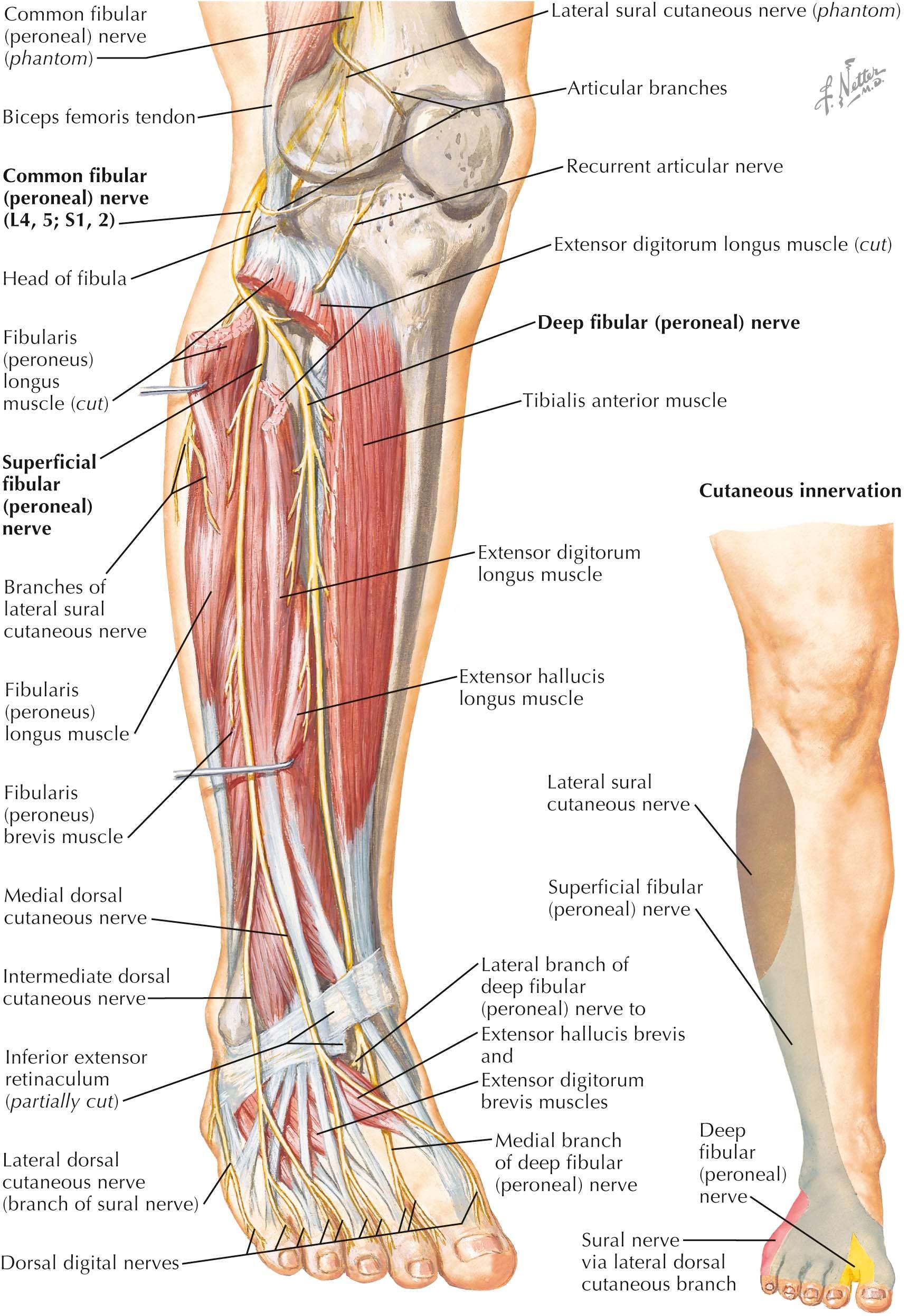
The common peroneal nerve (L4, 5; S1, 2) is the smaller, lateral, terminal branch of the sciatic nerve (see Plate 4-9 ). Its fibers are derived from the posterior divisions of the ventral rami of L4, L5, S1, and S2. From its origin, the nerve descends first along the lateral side of the popliteal fossa, overlapped by the medial margin of the biceps femoris; then it passes between the biceps tendon and the lateral head of the gastrocnemius muscle to reach the back of the fibular head; and, finally, it winds around the back and outer side of the neck of the fibula between the two heads of the peroneus longus muscle and divides into the superficial and deep peroneal nerves. At this point, the nerve can easily be compressed against the underlying bone.
Before dividing, the common peroneal nerve gives off three articular branches to the knee, which accompany the lateral superior and inferior genicular and anterior tibial recurrent arteries. It also gives off the lateral sural cutaneous nerve, which supplies the skin and fascia on the lateral and adjacent parts of the posterior and anterior surfaces of the upper part of the leg, and the peroneal communicating branch, which joins the sural branch of the tibial nerve and is distributed with it.
The superficial peroneal nerve descends between the extensor digitorum longus and peroneal muscles and supplies the peroneus longus and peroneus brevis muscles before piercing the deep fascia at about the junction of the middle and lower thirds of the leg. At this level, the nerve divides into medial and intermediate dorsal cutaneous nerves. The medial dorsal cutaneous nerve runs in front of the ankle and onto the dorsum of the foot, supplying twigs to the skin and fascia on the anterior surface of the distal third of the leg and the dorsum of the foot. Near the lower border of the inferior extensor retinaculum it splits into two dorsal digital nerves; one of these nerves supplies the medial and dorsal aspects of the dorsum of the foot and the great toe (except the first dorsal web space), whereas the other supplies the adjacent sides of the second and third toes. The intermediate dorsal cutaneous nerve runs along the lateral part of the dorsum of the foot, supplying the nearby skin and fascia and providing the dorsal digital nerves for the third and fourth and fourth and fifth toes. It communicates with the lateral dorsal cutaneous nerve, the termination of the sural nerve.
The deep peroneal nerve passes obliquely forward and downward around the fibular neck between the peroneus longus and the extensor digitorum longus muscles to the front of the interosseous membrane. It descends lateral to the tibialis anterior muscle and is a medial relation first to the extensor digitorum longus muscle and then to the extensor hallucis longus muscle, the tendon of which crosses the nerve obliquely above the ankle. In its downward course, the nerve first lies lateral to the anterior tibial vessels, then anterior to them, and finally lateral to them again in front of the lower end of the tibia and ankle, where the nerve divides into medial and lateral terminal branches. In the leg, the nerve sends branches to the tibialis anterior, extensor digitorum longus, extensor hallucis longus, and peroneus tertius muscles, an articular branch to the ankle, and filaments to the anterior tibial vessels. The medial terminal branch gives rise to a dorsal digital nerve, which splits to supply the contiguous sides of the first and second toes; notably the first dorsal web space. It also supplies filaments to the dorsalis pedis artery and nearby metatarsophalangeal and interphalangeal joints and, occasionally, a twig to the first dorsal interosseous muscle. The lateral terminal branch curves outward beneath the extensor digitorum brevis muscle, becomes slightly expanded, and gives off several slender offshoots to supply the extensor digitorum brevis muscle and its medial part (the extensor hallucis brevis muscle), the adjacent tarsal and tarsometatarsal joints, and, rarely, the second and third dorsal interosseous muscles.
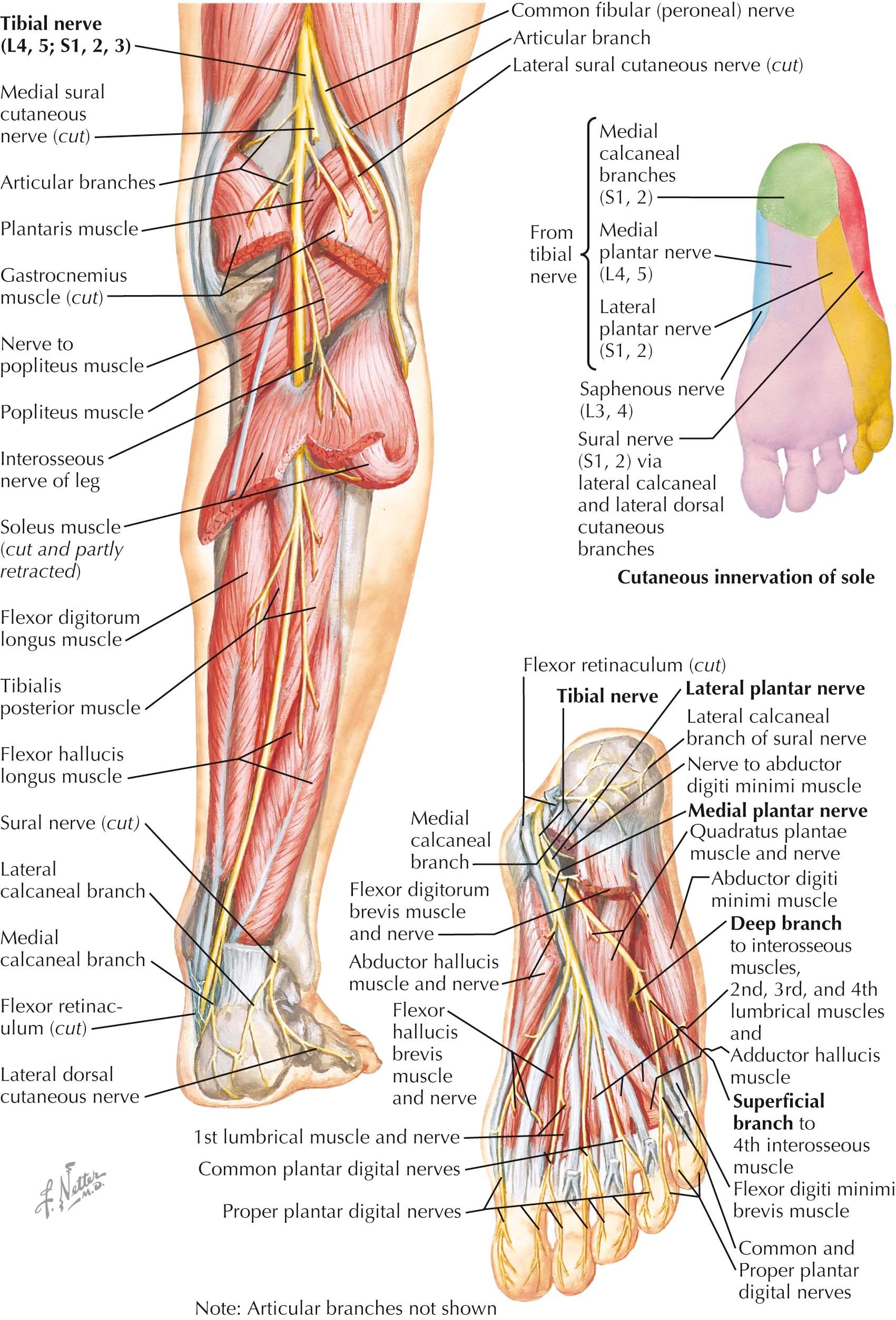
The tibial nerve (L4, 5; S1, 2, 3) is the larger, medial, and terminal branch of the sciatic nerve (see Plate 4-10 ). Its fibers are derived from the anterior divisions of the ventral rami of L4 and L5 and S1, S2, and S3.
The tibial nerve continues the line of the sciatic nerve through the popliteal fossa and into the leg. At its origin, the nerve is overlapped by the adjoining margins of the semimembranosus and biceps femoris muscles. In the popliteal fossa, the tibial nerve becomes more superficial, first lying lateral to the popliteal vessels and then crossing obliquely to their medial sides before disappearing into the leg between and beneath the heads of the gastrocnemius and plantaris muscles. Passing over the popliteus muscle and under the tendinous arch of the soleus muscle on the medial side of the posterior tibial vessels, the tibial nerve next enters the space between the gastrocnemius and soleus muscles behind and the upper part of the tibialis posterior muscle in front. Continuing downward, it crosses over the posterior tibial vessels to reach their lateral sides, so as to lie between the contiguous margins of the flexor digitorum longus and flexor hallucis longus muscles. In the distal third of the leg, the nerve is covered only by skin and fascia as it descends toward the ankle region, where it curves anteroinferiorly into the sole of the foot behind the medial malleolus, deep to the flexor retinaculum and between the tendons of the flexor hallucis longus and the flexor digitorum longus muscles. The nerve ends at this level by dividing into the medial and lateral plantar nerves.
The tibial nerve consists of muscular, articular, sural, calcaneal, and medial and lateral plantar main branches; it also gives off smaller osseous (medullary) and vascular twigs.
The muscular branches supply both heads of the gastrocnemius muscle and the plantaris, popliteus, soleus, tibialis posterior, flexor digitorum longus, and flexor hallucis longus muscles. Branches to the gastrocnemius, plantaris, and popliteus muscles and a few that enter the posterior surface of the soleus muscle arise in the popliteal fossa. The branch to the popliteus muscle descends over the posterior surface of the muscle, hooks around its inferior border, and ascends to enter its anterior surface. Branches to the deep surface of the soleus and to the tibialis posterior, flexor digitorum longus, and flexor hallucis longus muscles are given off in the upper third of the leg. Vasomotor filaments to the popliteal vessels arise from the main tibial nerve or from its branches in the popliteal fossa.
The articular branches help to supply the knee, ankle, and superior and inferior tibiofibular joints and may arise in common with twigs supplying adjacent muscles, bones, and vessels.
Become a Clinical Tree membership for Full access and enjoy Unlimited articles
If you are a member. Log in here